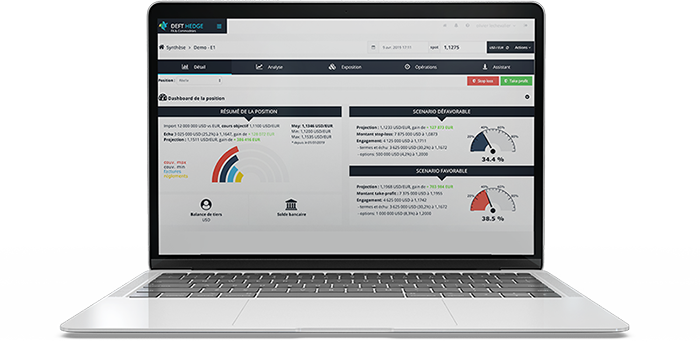Carbon price :
Discover our solution !

In order to best assess the environmental impact of production, a new economic tool has been developed: the carbon price. This price makes it possible to determine the amount of the hidden costs of damage linked to greenhouse gas emissions in the production of certain products. The aim of this price is to provide maximum incentive for economic agents to favour cleaner, low-carbon solutions. Today, this carbon price can be found on multiple markets around the world, where different economic actors can trade and exchange carbon emission allowances.
In order to best manage its strategy on this very specific market, it is necessary to have the most appropriate tools. In order to best meet the needs of professionals, DeftHedge has therefore designed its SaaS solution enabling professionals to guide and improve their management on the carbon market. Thanks to this tool, you will be able to accurately monitor the evolution of the carbon price and determine the best strategy to adopt for your business. To better understand how the carbon market works and the importance of the carbon price for your business, we return here in detail to this specific product.
What is the carbon price ?
The price of carbon is an economic instrument fixed on the various markets around the world.
It was created as a result of various measures and commitments to limit greenhouse gas emissions. Depending on the level of constraint on these markets, the price of carbon will vary greatly.
On these markets, the various players present can trade and buy “rights to pollute”. The establishment of these markets enables States to better measure and control greenhouse gas emissions, with the aim of reducing them as much as possible.
Charging for this right to pollute should thus encourage economic actors to turn to cleaner and therefore cheaper solutions for their production.
What are the different carbon quotation markets ?
The concept of the carbon market, which appeared at the beginning of the 21st century, is now present worldwide with more than 21 markets in existence.
With the aim of limiting the environmental damage caused by our economies, these markets operate according to different standards and rules. Indeed, depending on jurisdictional scales, the climate policy in place may vary.
These differences between markets will have significant impacts on the price of carbon: between $1 and $35 per tCO2 depending on the market.
Today, the 21 existing markets are set up by 28 jurisdictions in three main geographical areas: Europe, North America and Asia.
At the European level, the European Union Emissions Trading Scheme (EU ETS) is in place. This emissions trading market is today the most important platform worldwide.
This platform connects companies that can reduce their emissions and thus sell their right to pollute to companies that cannot reduce them.
The most polluting companies are therefore obliged to acquire these rights to pollute under threat of financial penalties.
The aim is therefore to provide the maximum incentive for companies to reduce their greenhouse gas emissions by adopting a cleaner production method.
What are the quotation methods for carbon ?
Although the price of carbon is not imposed in all regions of the world, this value is now fully taken into account by companies.
Indeed, in some geographical areas, the cost of this right to pollute represents a significant amount in production.
The carbon price quotation can vary greatly from one region to another, depending on the level of constraint of the government measures in place.
In order to set a carbon price, States can apply a “Carbon Tax” or set up the carbon market system.
There are also other methods of putting a price on carbon:
Increasing fuel taxes
Removal of certain subsidies for fossil fuels
Implementation of emission standards
Creation of energy saving certificates
What is the global evolution of carbon ?
As the fight against climate change tends to become more and more widespread, the cost of carbon is expected to continue to rise over the years.
Indeed, the objective is to identify as much as possible the hidden costs in the production of certain products in order to determine the negative effects of certain productions on the environment.
According to the World Bank, “putting a price on carbon helps to put the burden of damage resulting from greenhouse gas emissions on those who are responsible for them and who are in a position to reduce them”.
In this sense, in its research, the Centre d’Analyse Stratégique (CAS) estimates that the cost of a tonne of CO2 could reach an average of €100 in 2030 and around €200 by 2050.
What are the advantages of the carbon exchange ?
Setting up a carbon exchange provides an incentive for companies to reduce their greenhouse gas emissions by obtaining financial compensation for this reduction effort.
By putting in place the appropriate measures to make their production cleaner, companies will not have to buy these rights to pollute and can therefore even obtain financial compensation by selling them.
The effectiveness of this measure can be increased by involving non-user rights buyers.
Indeed, by allowing governments or environmental groups to buy rights to pollute, this can allow speculation on the cost of carbon and thus increase pressure to reduce emissions.
Depending on the different global markets in place, these buying and selling rules may vary.
How will the DeftHedge solution help you with carbon price monitoring ?
DeftHedge is a SaaS solution for the day-to-day business of professionals, specialising in currency and commodity management.
Among the needs in commodities management, professionals may be confronted with the management and monitoring of carbon prices.
This product appears to be particularly specific as it relates to a “right to pollute” which can represent a particularly high cost depending on the level of constraint put in place by the authorities.
Good management of the cost of carbon is therefore essential today for companies to adapt their development strategy as best as possible.
To help professionals in this management, DeftHedge has therefore developed a SaaS solution to simplify and optimise the management of the price of carbon.
On a daily basis, you will be able to access numerous functionalities:
Carbon price management and monitoring
Automation of multiple time-consuming tasks
Simulation of strategy implementation
Data centralisation and security
Optimisation of finances
Thanks to this tool, professionals can better manage their carbon sales or purchases on the markets.
At the European level, this tool is particularly useful for finding the best strategy to adopt on the European Union Emissions Trading Scheme.
Indeed, today carbon represents a point not to be neglected for companies since it is at the heart of the measures in place to fight against climate change.
It is therefore essential to adapt your strategy for selling your rights or buying is essential to guide your activity and the various measures to be taken to reduce the environmental impact of your production.
In your daily management, DeftHedge will quickly become a must.
Knowing that the value of carbon will tend to increase over the years, it is therefore important to take this into account in order to adopt the best strategy to avoid your carbon budget growing from year to year.
In order to reduce uncertainty and identify the best strategy for your business, DeftHedge has a tool: “SmartStrategy”.
Based on the various information provided about your business, this tool will allow you to simulate several strategies and determine the best measures to take to optimise your finances.
A tool that is therefore indispensable for effectively reducing your carbon budget.
For the management of raw materials, and in particular carbon, DeftHedge will thus be a real asset for the efficient management and optimisation of your finances.
Very quickly, you will see the effects of using our software on your business by considerably improving your monitoring and management of your sales and purchases on the carbon market.
Complete and perfectly adapted to your professional activity, our financial forecasting software is the ideal tool for your daily life. In order to make it easier for you to use our solution, our experts are at your side to guide you and help you customise the different functionalities as best as possible.
In order to best anticipate carbon price trends and adopt the best possible strategy on this market, do not hesitate to opt for DeftHedge.
